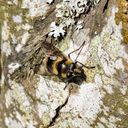Milesiini
Milesiini
Classification
- Phylum: Arthropoda
- Subphylum: Hexapoda
- Class: Insecta
- Order: Diptera
- Family: Syrphidae
- Subfamily: Eristalinae
- Tribe: Milesiini
Pronunciation
How to pronounce Milesiini: //ˌmaɪlɛˈsiiːnaɪ//
These audio files are automatically generated. While they are not always 100% accurate, they are a good starting point.
Images






Summary
The Milesiini tribe of hoverflies is notable for its wasp-like appearance and ecological role as pollinators, comprising a large variety of genera found in diverse habitats.
Physical Characteristics
Milesiini hoverflies exhibit a robust body shape and are often characterized by their distinctive coloration, which helps them mimic wasps or hornets.
Identification Tips
Look for the wasp-like appearance and coloration patterns. They are typically larger than most other hoverflies, with elongated bodies and banded patterns.
Habitat
Milesiini species are commonly found in a variety of habitats, including woodland edges, meadows, and gardens. They are often associated with flowers where they feed on nectar.
Distribution
This tribe is widely distributed, found in various regions across the globe, particularly in temperate and tropical areas.
Diet
Adults primarily feed on nectar and pollen, making them important pollinators. Larvae may feed on decaying organic matter or within the larval habitats of other insects.
Life Cycle
The life cycle of Milesiini involves egg, larval, pupal, and adult stages, with larvae often developing in habitats rich in organic material.
Reproduction
Mating typically occurs in flight and females lay eggs near food sources for the larvae.
Predators
Potential predators include birds and larger insects that might mistake them for actual wasps or hornets due to their mimicry.
Ecosystem Role
Milesiini hoverflies play a significant role in pollination, contributing to the reproduction of flowering plants.
Economic Impact
Their role as pollinators can support agricultural productivity, particularly in crops that rely on insect pollination.
Collecting Methods
- Netting adults in flight
- Using traps baited with attractants
Preservation Methods
- Ethanol preservation
- Drying and pinning specimens
Evolution
Milesiini have evolved complex mimicry strategies, enhancing their survival against predators by resembling more dangerous insects like wasps and hornets.
Misconceptions
Many people mistake Milesiini hoverflies for actual wasps due to their appearance, not realizing they are harmless and beneficial pollinators.
Tags
- hoverflies
- pollinators
- mimicry
- Syrphidae
- Milesiini